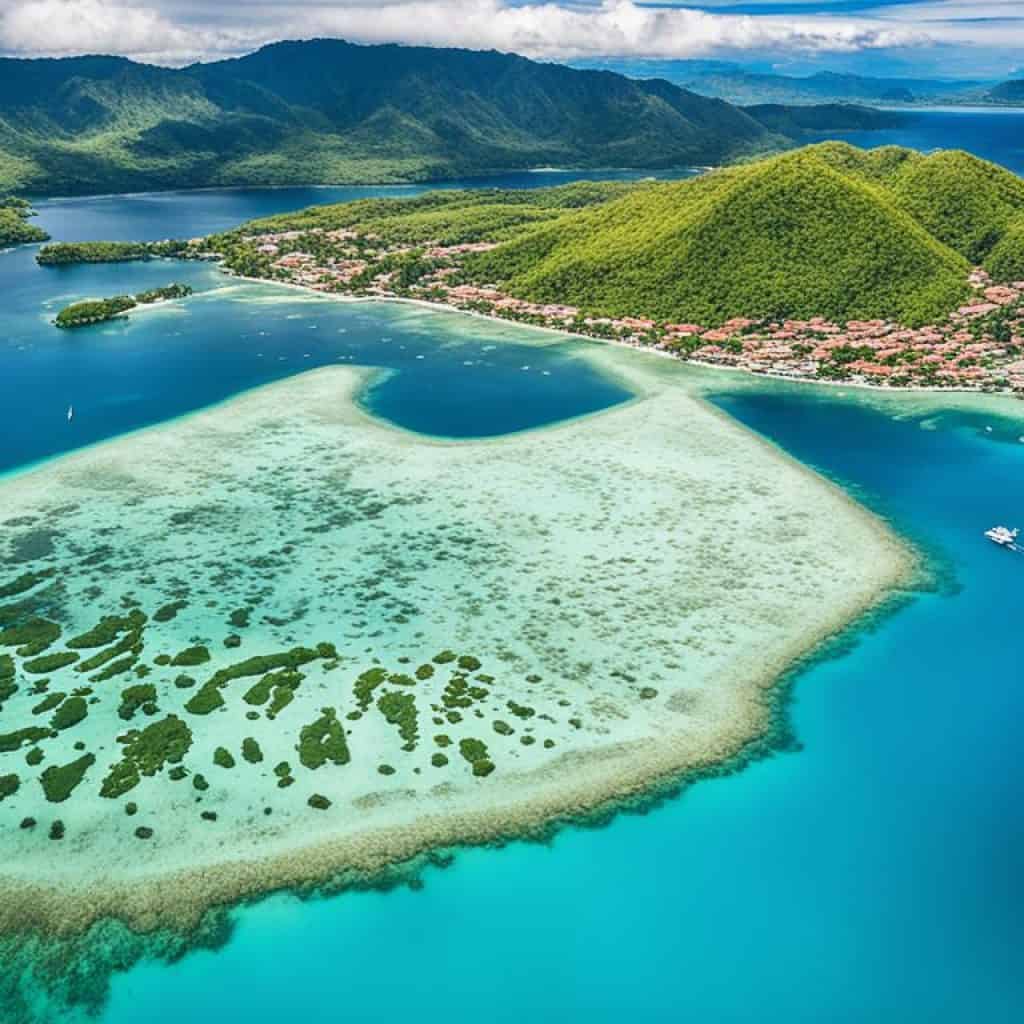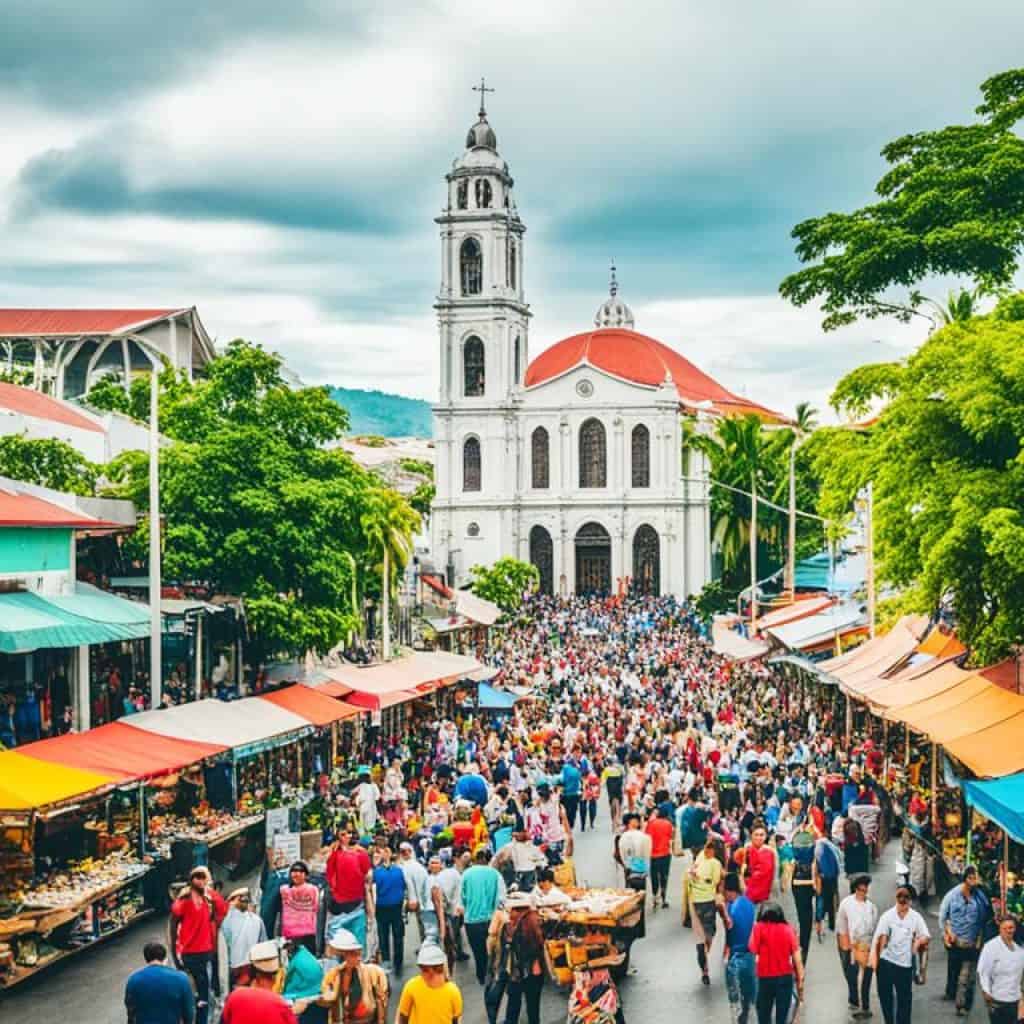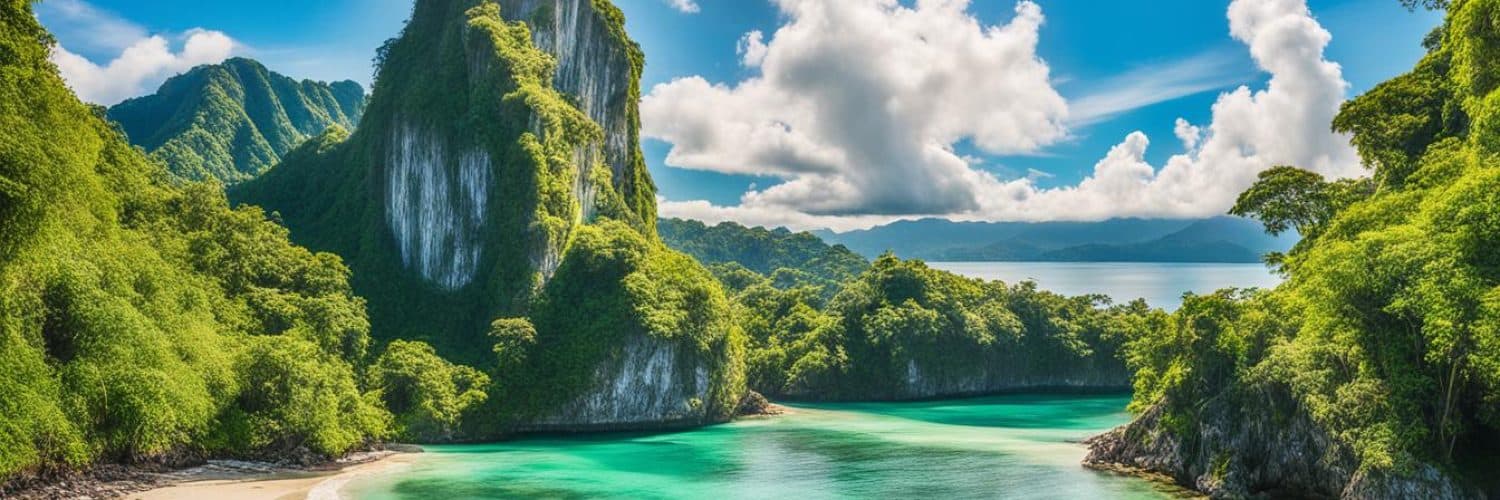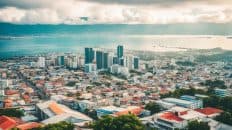Did you know that Cebu Island, nestled in the Central Visayas region of the Philippines, boasts a geography as diverse as its attractions? From breathtaking mountains to pristine beaches and vibrant cities, Cebu has it all. But what makes Cebu’s geography truly unique? Let’s delve into the remarkable landscapes, natural wonders, and cultural experiences that await you on this captivating island.
The geography of Cebu is a tapestry of stunning contrasts. Picture yourself standing atop the towering Osmeña Peak, the highest mountain in Cebu, with panoramic views of lush valleys and rolling hills stretching as far as the eye can see. And just beyond the magnificent mountains lie breathtaking beaches with crystal-clear waters that beckon sunseekers and water sports enthusiasts.
Key Takeaways:
- Cebu Island offers a diverse geography, including mountains, beaches, and cities.
- The island is known for Osmeña Peak, the highest point in Cebu.
- Cebu’s geography provides a wide range of natural wonders and cultural experiences to explore.
- The island’s mountains offer spectacular views and hiking opportunities.
- Cebu’s beaches boast crystal-clear waters and pristine white sand.
Discover the Topography of Cebu
Cebu Island, located in the Central Visayas region of the Philippines, boasts a unique topography that adds to its natural beauty and diverse landscapes. With a long and narrow shape, stretching approximately 196 kilometers from north to south, the island offers a range of geographical features to explore.
The topography of Cebu is predominantly mountainous, with stunning peaks that reach breathtaking heights. The highest peak, Osmeña Peak, stands tall at 1,013 meters above sea level, providing panoramic views of the surrounding terrain. These magnificent mountains make Cebu a popular destination for hiking and trekking enthusiasts, offering thrilling adventures and unforgettable experiences.
Aside from its majestic mountains, Cebu also showcases valleys, plateaus, and coastal plains. These diverse landscapes contribute to the overall charm of the island, offering opportunities for various outdoor activities. Whether you’re looking to conquer mountain trails, explore picturesque valleys, or relax on pristine beaches, the topography of Cebu caters to every adventurer’s desires.
Mountain Peaks in Cebu
One of the standout features of Cebu’s topography is its collection of notable mountain peaks. Here are some of the awe-inspiring mountains you can discover in Cebu:
- Osmeña Peak – The highest peak on the island, providing stunning views of the surrounding landscape.
- Mount Manunggal – A historic mountain with a monument commemorating the crash site of President Ramon Magsaysay’s plane in 1957.
- Mount Babag – A challenging hiking spot that rewards climbers with breathtaking vistas at the summit.
These mountains offer a chance to connect with nature, escape from the hustle and bustle of city life, and immerse yourself in the serene beauty of Cebu’s topography.
“Cebu’s topography showcases a picturesque blend of mountains, valleys, plateaus, and coastal plains, making it an ideal destination for nature lovers and adventure seekers.”
Activities in Cebu’s Diverse Terrain
The varied topography of Cebu presents endless opportunities for outdoor activities and exploration. Here are some of the exciting adventures you can embark on:
- Hiking and Trekking – Conquer the trails of Osmeña Peak or explore the rugged beauty of Mount Manunggal and Mount Babag.
- Exploring Valleys – Discover hidden gems nestled within Cebu’s valleys, offering lush greenery and stunning natural landscapes.
- Beachside Relaxation – Indulge in the coastal plains of Cebu, where you can bask in the sun, swim in crystal-clear waters, and unwind on pristine beaches.
Whether you seek thrilling adventures or peaceful relaxation, Cebu’s topography provides an ideal setting for a variety of outdoor activities.
Cebu’s topography truly showcases the diversity and natural beauty of the island. From towering peaks to tranquil valleys, this paradise offers a wealth of exploration and adventure for visitors. So, pack your bags, put on your hiking shoes, and get ready to immerse yourself in the breathtaking topography of Cebu.
Uncover the Natural Resources of Cebu
Cebu, a province in the Philippines, is not only known for its stunning landscapes and vibrant cities but also for its abundant natural resources. The island is blessed with a diverse range of resources that contribute to its economic growth and development.
One of the key natural resources in Cebu is its fertile soil. This rich soil supports the agricultural industry and enables the cultivation of various crops, including corn, rice, and coconuts. The agricultural sector plays a vital role in the province’s economy, providing employment opportunities and contributing to food security.
“Cebu’s fertile soil is a testament to its thriving agricultural industry. The province is known for producing high-quality crops that not only sustain the local population but are also exported to other regions.”
In addition to its fertile soil, Cebu is renowned for its rich marine resources. The surrounding seas are teeming with various species of fish and shellfish, making it a haven for fishermen and seafood enthusiasts. The thriving fishing industry not only supports local livelihoods but also supplies fresh seafood to markets and restaurants across the province.
Moreover, Cebu is home to valuable mineral deposits, including limestone. Limestone is a critical resource used in construction and cement production. The mining industry in Cebu extracts limestone from quarries, supporting the province’s infrastructure development and providing materials for the construction sector.
By harnessing its natural resources, Cebu sustains economic growth and ensures the well-being of its residents. The province’s commitment to sustainable resource management plays a crucial role in preserving the environment and promoting responsible economic practices.
Economic Importance of Natural Resources in Cebu
The natural resources of Cebu serve as the backbone of several key industries, contributing to the economic prosperity of the province:
| Industry | Contribution |
|---|---|
| Agriculture | Provides livelihoods and food security through the cultivation of crops. |
| Fishing | Supports the fishing industry, supplying fresh seafood to local and international markets. |
| Mining | Utilizes mineral resources like limestone for construction and cement production. |
The sustainable management of these natural resources ensures the long-term viability of these industries and contributes to the overall growth and prosperity of Cebu.
Experience the Climate of Cebu
Cebu, located in the Central Visayas region of the Philippines, boasts a tropical climate that entices visitors throughout the year. The province experiences two distinct seasons: the dry season, which runs from November to April, and the wet season, which encompasses the months from May to October. With an average temperature ranging from 25 to 32 degrees Celsius (77 to 90 degrees Fahrenheit), Cebu provides a warm and inviting environment for travelers seeking a tropical escape.
During the dry season, visitors can expect sunny days accompanied by balmy temperatures, perfect for exploring the province’s stunning natural beauty. Cebu’s beautiful beaches, such as the renowned Mactan Island, beckon sun-worshippers to bask in the golden rays and take a refreshing dip in the crystal-clear waters.
On the other hand, the wet season in Cebu brings occasional rainfall, which nourishes the lush landscapes and gives rise to verdant, breathtaking scenery. Although typhoons are a possibility during this season, they are relatively rare and tend to affect the province less severely compared to other regions in the Philippines.
“Cebu’s tropical climate creates a welcoming environment for both agriculture and tourism, ensuring a fruitful and enjoyable experience for visitors.”
The climate in Cebu sets the stage for a flourishing agricultural industry. The province’s fertile soil, combined with ample precipitation, supports the growth of various crops, including corn, rice, and coconuts. In addition, the province’s marine resources thrive under the favorable climatic conditions, offering abundant fish and shellfish species for both sustenance and economic purposes.
Climate in Cebu at a Glance
| Season | Average Temperature |
|---|---|
| Dry Season (November – April) | 25 to 32 degrees Celsius (77 to 90 degrees Fahrenheit) |
| Wet Season (May – October) | 25 to 32 degrees Celsius (77 to 90 degrees Fahrenheit) |
Whether you’re planning a beach getaway, an exploration of the lush mountains and valleys, or a cultural immersion in Cebu’s vibrant cities, the province’s favorable climate sets the stage for a memorable adventure. Pack your sunglasses, sunscreen, and a spirit of adventure, as Cebu awaits, promising warm days, breathtaking landscapes, and endless possibilities for fun and relaxation.
Explore the Geographical Location of Cebu
Cebu is situated in the Central Visayas region of the Philippines, nestled within the Visayas Island Group. This province is located in the eastern part of Cebu Island, bordered by the Camotes Sea on the east and the Tañon Strait on the west. Its strategic geographical location positions Cebu as a major transportation hub and trading center.
Cebu’s central position within the Philippines allows for easy accessibility from other parts of the country, making it a popular destination for both local and international travelers. Whether you’re arriving by air, sea, or land, Cebu’s geographical location ensures convenient connections to explore its diverse geography.
The province’s unique position enhances its role as a gateway to the Visayas, offering a starting point for island hopping adventures to nearby destinations like Bohol and Negros. The proximity to Cebu’s neighboring islands allows for seamless exploration of the surrounding natural wonders.
Additionally, Cebu’s geographical location contributes to its economic growth and development. The province’s accessibility and connectivity make it an attractive destination for businesses, trade, and investment. Cebu serves as a vital hub for both domestic and international trade, fostering economic opportunities and cultural exchange.
Key Geographic Features of Cebu:
- Central Visayas region in the Philippines
- Located in the eastern part of Cebu Island
- Bordered by the Camotes Sea (east) and the Tañon Strait (west)
- Strategic transportation hub and trading center
- Easy accessibility from other parts of the country
- Gateway to the Visayas Island Group
- Convenient connections to neighboring islands
- Supports economic growth and development
With its favorable geographical location, Cebu invites you to embark on an unforgettable journey through its scenic landscapes, stunning beaches, and vibrant cities.
Discover the Charm of Cebu Island
Cebu Island, located in the Visayas region of the Philippines, is a true gem offering a captivating blend of diverse geographical features and natural attractions. Whether you’re a beach lover, a nature enthusiast, or a history buff, Cebu Island has something special to offer.

One of the highlights of Cebu Island is its stunning beaches. From the popular resort destination of Mactan Island to the remote and untouched beauty of Malapascua Island, you’ll find pristine white sands and crystal-clear waters to immerse yourself in. Whether you want to relax under the sun, go snorkeling or diving, or indulge in water sports, Cebu Island’s beaches will exceed your expectations.
The island is also blessed with lush mountains and scenic hiking trails. Osmeña Peak, the highest peak on Cebu Island, offers panoramic views of the surrounding landscapes, making it a favorite spot for adventurers and nature lovers. Hike through verdant forests, explore hidden waterfalls, and discover the picturesque beauty that awaits at every turn.
Exploring Cebu Island’s Highlights
| Beaches | Mountains and Hiking Trails | Historical and Cultural Sites |
|---|---|---|
| Mactan Island | Osmeña Peak | Cebu City |
| Malapascua Island | Mount Manunggal | Fort San Pedro |
| Bantayan Island | Mount Babag | Magellan’s Cross |
Cebu Island is dotted with vibrant cities, with Cebu City being the most prominent. Known as the oldest city in the Philippines, Cebu City is a melting pot of history, culture, and modernity. Explore the colonial architecture, visit historical landmarks such as Fort San Pedro, and embrace the vibrant atmosphere as you stroll through the lively streets.
The charm of Cebu Island lies in its varied geography, offering a diverse array of experiences for every traveler. Whether you’re seeking relaxation, adventure, or cultural immersion, Cebu Island has it all. Immerse yourself in the beauty of its beaches, unleash your sense of adventure in the mountains, and discover the rich history and culture that permeates the island.
Plan your journey to Cebu Island and be prepared to be enchanted by its natural wonders and warm hospitality. With its captivating geography, this island paradise is truly a destination that will leave you with unforgettable memories.
Experience the Terrain of Cebu
The terrain of Cebu offers a captivating mix of rugged mountains and fertile coastal plains, creating a diverse landscape that caters to outdoor enthusiasts and agriculture alike. The island is renowned for its majestic peaks and valleys, providing a picturesque backdrop for adventurous activities.
The highlight of Cebu’s terrain is the impressive Osmeña Peak, the highest point on the island. Towering at 1,013 meters, it offers breathtaking views of the surrounding landscapes and rewards hikers with a sense of accomplishment. Trekking through its challenging trails is a must for thrill-seekers and nature lovers looking to immerse themselves in Cebu’s natural beauty.
While the mountainous regions steal the limelight, Cebu also boasts coastal plains that nurture a thriving agricultural industry. These plains support a variety of crops, including corn, rice, and coconuts, contributing to the province’s economy and ensuring a sustainable source of food for its residents.
With such varied terrain, Cebu offers endless opportunities for outdoor activities. Whether it’s trekking through lush forests, mountaineering, or camping in serene valleys, the province provides a playground for nature enthusiasts. Discover hidden escape routes, witness panoramic views of the surroundings, and uncover the raw beauty of Cebu’s terrain.
Embark on an unforgettable adventure and witness the wonders of Cebu’s varied terrain. From conquering the heights of Osmeña Peak to strolling through the fertile plains, Cebu offers a myriad of experiences that will leave you in awe of its natural beauty.
Discover the Geographic Characteristics of Cebu
Cebu is a province characterized by its diverse geographic features that create a unique and captivating landscape. From towering mountains and pristine beaches to picturesque valleys and expansive plateaus, Cebu offers a mesmerizing blend of natural beauty and cultural heritage. Whether you’re a nature lover or a history enthusiast, this province has something to offer for everyone.
Mountains and Peaks
Cebu is adorned with majestic mountains and peaks that provide breathtaking views and exhilarating adventures. One notable mountain is Osmeña Peak, the highest peak in Cebu, offering awe-inspiring panoramas of the surrounding landscape. Hiking enthusiasts and nature lovers can immerse themselves in the beauty of these peaks, exploring the wonders of Cebu’s mountainous terrains.
Stunning Beaches
The province of Cebu boasts an array of stunning beaches with crystal-clear waters and powdery white sand. From the popular Mactan Island, known for its luxurious resorts and vibrant water sports activities, to the hidden gems like Malapascua Island, there are endless options to enjoy the sun, sand, and sea in Cebu. Whether you prefer relaxation or adventure, Cebu’s beaches cater to all your desires.
“Cebu’s geographic characteristics offer a mix of natural attractions and cultural sites, making it a popular destination for both nature lovers and history enthusiasts.”
Valleys and Plateaus
Cebu’s valleys and plateaus are a testament to the province’s rich natural diversity. These fertile lands serve as agricultural hubs, supporting the cultivation of crops such as corn, rice, and coconuts. Exploring the scenic valleys and plateaus of Cebu provides a glimpse into the province’s thriving agricultural heritage and offers a serene escape from the bustle of city life.
Coastal Plains
Cebu is adorned with picturesque coastal plains that stretch along its shores. These plains are not only aesthetically pleasing but also serve as thriving habitats for marine life. The coastal plains of Cebu provide a myriad of opportunities for beachside activities, such as swimming, snorkeling, and enjoying serene coastal walks.
The geographic characteristics of Cebu, ranging from mountains to beaches, valleys to plateaus, and coastal plains, contribute to the province’s allure and charm. This remarkable blend of natural wonders and cultural treasures makes Cebu a truly captivating destination for travelers seeking to immerse themselves in the beauty and rich heritage of the province.
Explore Cebu City: The Heart of the Province
Cebu City, located on the eastern coast of Cebu Island, is the vibrant capital of Cebu province. As the main center of commerce, trade, and industry in the Visayas, Cebu City serves as a bustling hub of activity. With its captivating blend of modernity and history, this city offers a myriad of experiences for visitors.
Known for its stunning urban landscape, Cebu City boasts bustling streets, towering skyscrapers, and a lively atmosphere. As you navigate the city, you’ll be greeted by a vibrant mix of cultures and a welcoming local community.
“Cebu City is a melting pot of cultures and a testament to the province’s rich history and vibrant present. The city’s urban landscape, bustling streets, and iconic landmarks make it a must-visit for anyone exploring the province.”
Cebu City is home to a treasure trove of iconic landmarks and historical sites that showcase its enduring heritage. Explore the famous Magellan’s Cross, a significant symbol of Christianity in the Philippines. Admire the intricate architecture of the Cebu Metropolitan Cathedral, a stunning testament to the city’s colonial past.
When strolling through the city, immerse yourself in the local culture and sample tantalizing local cuisine. From the famous lechon (roast pig) to mouthwatering seafood dishes, Cebu City’s culinary scene is a delightful adventure for every food lover.
To truly understand the heart and soul of Cebu, take a leisurely walk along the colorful streets of Colon Street, the oldest street in the Philippines. Here, you’ll find a vibrant tapestry of shops, markets, and street food stalls that are a testament to the city’s dynamic energy.
Whether you’re browsing through trendy malls or exploring local markets, Cebu City’s shopping scene offers a diverse array of options. From high-end boutiques to budget-friendly finds, you’ll discover treasures and souvenirs to commemorate your visit to this vibrant city.
Image related to the geography of Cebu City:
Delve into the Rich History of Cebu City
Cebu City boasts a fascinating history that can be traced back to the arrival of Ferdinand Magellan in 1521. As the first Spanish settlement in the Philippines, it holds a significant place in the country’s colonial past. For several decades, the city served as the center of Spanish colonial power. Today, visitors can explore the historical sites that bear witness to Cebu City’s storied past.
One of the notable historical sites in Cebu City is Fort San Pedro, which is considered the oldest fort in the Philippines. Built by the Spanish conquistadors in the 16th century, this triangular-shaped fort played an important role in defending the city against attacks. A visit to Fort San Pedro allows you to immerse yourself in the rich history of Cebu City and learn about its strategic military significance.
Another iconic historical landmark in Cebu City is Magellan’s Cross. Planted by Ferdinand Magellan himself in 1521, this cross symbolizes the introduction of Christianity to the Philippines. It stands as a testament to the city’s religious heritage and serves as a popular pilgrimage site for both locals and tourists.
“Cebu City is a treasure trove of historical sites that offer glimpses into its past. From the old-world charm of Fort San Pedro to the spiritual significance of Magellan’s Cross, these landmarks reflect the city’s rich cultural heritage and serve as reminders of its historical significance.”
– Local historian
Moreover, Cebu City’s history is deeply intertwined with the history of the province. The city has witnessed the rise and fall of empires, the wave of colonization, and the struggles for independence. Exploring Cebu City allows you to delve into the stories of the people who shaped its destiny and gain a deeper understanding of the cultural tapestry that makes up the city today.
| Historical Sites | Description |
|---|---|
| Fort San Pedro | Ancient fort, built in the 16th century, served as a stronghold against attacks. |
| Magellan’s Cross | The cross planted by Ferdinand Magellan, symbolizing the introduction of Christianity. |
| Colon Street | Oldest street in the Philippines, lined with historic buildings and landmarks. |
| Basilica Minore del Santo Niño | Oldest Roman Catholic Church in the country, containing the revered Santo Niño image. |
Embarking on a journey through Cebu City’s historical sites is like stepping back in time. These landmarks serve as living testaments to the city’s past, allowing visitors to appreciate the rich history and cultural heritage that have shaped Cebu City into what it is today.
Experience the Vibrant Culture of Cebu City
Cebu City, the bustling urban center of Cebu province, is not just known for its historical landmarks but also for its vibrant and diverse culture. The city is a true melting pot, blending influences from its rich Spanish and Filipino heritage. This unique fusion of cultures has shaped Cebu City into a vibrant and dynamic destination that offers visitors a taste of traditional and modern experiences.
One of the highlights of Cebu City’s cultural scene is its festivals. The Sinulog Festival, held every January, is a vibrant celebration of faith and culture. Locals and tourists gather to witness the colorful street parade, showcasing traditional dance performances and elaborate costumes. The festival pays homage to the Santo Niño, the city’s beloved patron saint, and is a testament to Cebuano’s religious devotion and cultural pride.
Aside from festivals, Cebu City is also a culinary paradise. The city’s local cuisine is a rich tapestry of flavors and influences that reflect its cultural diversity. From the famous lechon, a mouthwatering roasted pig, to the fragrant and flavorful sutukil, a combination of seafood cooked in different ways, there is no shortage of delicious dishes to try. Cebu City’s food scene also offers a variety of street food, night markets, and restaurants, ensuring that every foodie’s cravings are satisfied.
Experience Cebu City’s vibrant culture through its festivals and tantalize your taste buds with its diverse local cuisine. Immerse yourself in the city’s unique blend of traditions and flavors, and let the vibrant energy of Cebu City captivate your senses.
| Festival | Description |
|---|---|
| Sinulog Festival | A grand celebration of faith and culture, featuring a street parade, dance performances, and colorful costumes. |
| Pasigarbo sa Sugbo | A showcase of Cebu’s cultural heritage, featuring traditional dances, music, and arts. |
| Pahinungod Festival | A festival honoring the city’s patron saint, highlighting religious processions and cultural activities. |

Discover the Pristine Beaches of Cebu
Cebu is renowned for its stunning beaches, offering crystal-clear waters and pristine white sand. Whether you’re looking for relaxation, water adventures, or simply soaking up the sun, Cebu’s beaches have something for everyone. From the popular Mactan Island, known for its resorts and water sports activities, to the untouched beauty of Malapascua Island, there are numerous beach destinations to explore in Cebu.
One of the must-visit beaches in Cebu is Bantayan Island. Located in northern Cebu, Bantayan Island boasts powdery white sand and turquoise waters. It’s the perfect place to unwind and enjoy a quiet beach getaway. Guintarcan Island, also known as Kinatarcan Island, is another hidden gem in Cebu. With its secluded beaches and laid-back atmosphere, Guintarcan Island offers a tranquil escape from the bustling city life.
For those seeking adventure, Moalboal is a popular beach destination in Cebu known for its vibrant marine life. Snorkeling and diving enthusiasts flock to Moalboal to explore its pristine coral reefs and swim with the majestic sea turtles. Another beach worth visiting is Sumilon Island, known for its shifting sandbar. During low tide, the sandbar emerges, creating a stunning natural spectacle.
The beaches of Cebu not only offer natural beauty but are also gateways to unique experiences. Whether you want to relax by the shore, engage in thrilling water sports, or explore the underwater world, Cebu’s beaches will exceed your expectations.
Plan your trip to Cebu and discover the pristine beaches that make this province a dream destination. Explore the diverse coastline, indulge in beachside relaxation, and create unforgettable memories. With its breathtaking beaches, Cebu is truly a paradise for beach lovers.
Experience the Adventure of Cebu’s Mountains
Cebu’s stunning mountains offer thrilling adventures for outdoor enthusiasts. With its diverse terrain, the province is a paradise for hiking and exploration, allowing visitors to immerse themselves in nature and witness the breathtaking beauty of the island from a unique perspective.
One of the must-visit mountains in Cebu is Osmeña Peak, the highest peak on the island. Hiking to the summit rewards trekkers with awe-inspiring panoramic views of the surrounding landscapes. As you stand atop Osmeña Peak, you’ll be treated to endless rolling hills, lush greenery, and a sense of accomplishment that comes from conquering nature’s majestic heights.
For those looking for a more challenging hiking experience, Mount Manunggal and Mount Babag are popular choices. These mountains offer rugged trails, steep ascents, and the opportunity to test your limits. As you ascend these peaks, you’ll be rewarded with magnificent vistas, refreshing mountain air, and a profound connection with the natural world.
Exploring the mountains in Cebu is not just about the physical challenge, but also about the opportunity to disconnect from the bustling city life and reconnect with nature. Each step on the trails brings you closer to the wonders of the island’s biodiversity, where you might catch a glimpse of rare plants, colorful birds, or even encounter wildlife along the way.
Whether you’re an experienced hiker or a beginner looking for an adventure, Cebu’s mountains offer something for everyone. The trails cater to different skill levels, ensuring that there’s a hiking route suitable for you. It’s a chance to challenge yourself, breathe in the fresh mountain air, and embrace the beauty of the natural world.
Things to Keep in Mind:
- Check weather conditions and trail accessibility before embarking on any hiking adventure.
- Wear proper hiking shoes, comfortable clothing, and bring necessary gear such as a backpack, water, and a hat.
- Travel in groups or with experienced guides for safety and guidance.
- Leave no trace: respect the environment by not littering and taking care of the trails you hike.
Embark on an unforgettable journey through Cebu’s mountains, where breathtaking vistas, challenging trails, and a deep connection with nature await. Whether you’re conquering the heights of Osmeña Peak or venturing into the rugged terrain of Mount Manunggal and Mount Babag, the adventure of a lifetime awaits in Cebu’s majestic mountains.
Immerse Yourself in the Vibrant Nightlife of Cebu
When the sun sets in Cebu City, a whole new world comes alive. Known for its vibrant nightlife, the city offers a diverse range of experiences that cater to all tastes. From bustling bars to lively pubs and electrifying clubs, Cebu City has something for every nightlife enthusiast.
Step into the heart of the city and immerse yourself in the energetic atmosphere. The streets come alive with live entertainment, music, and laughter. Feel the rhythm of the music pulsating through the air as you make your way from one venue to another.
For those looking to dance the night away, Cebu City offers a variety of clubs that play an eclectic mix of music genres. Whether you’re into hip-hop, electronic, or local tunes, you’ll find a spot where you can let loose and show off your moves.
If you prefer a more relaxed evening, the city is home to cozy pubs where you can enjoy a drink with friends or strike up a conversation with fellow travelers. Sip on a refreshing cocktail, sample local craft beers, or indulge in a fine selection of wines while taking in the vibrant atmosphere.
The nightlife in Cebu City isn’t just about the music and drinks; it’s also a chance to immerse yourself in the local culture. Experience the warmth and hospitality of the Filipino people as you interact with locals and fellow revelers. Share stories, make new friends, and create memories that will last a lifetime.
No matter what your idea of a perfect night out is, Cebu City has you covered. The city’s vibrant entertainment scene adds another dimension to the Cebu experience, offering a lively and unforgettable night for everyone.
So, whether you’re looking to dance until dawn, enjoy live performances, or simply relax in a laid-back pub, Cebu City’s nightlife has something to suit every taste. Don’t miss the opportunity to immerse yourself in the vibrant energy and unforgettable experiences that await you in Cebu City.
Plan Your Ultimate Adventure in Cebu
With its diverse geography and abundance of natural attractions, Cebu is the perfect destination for adventure seekers and explorers. Whether you’re looking for thrilling hikes, exhilarating dives, or simply relaxing on beautiful beaches, Cebu has something to suit every taste. Here are some of the top things to do in Cebu for an unforgettable adventure:
1. Hiking
Cebu’s mountains offer breathtaking views and challenging hiking trails for outdoor enthusiasts. Head to Osmeña Peak, the highest peak on the island, and conquer its majestic summit. The panoramic vista from the top is truly awe-inspiring. Don’t forget to explore other notable mountains like Mount Manunggal and Mount Babag, each with their own unique landscapes and adventures.
2. Diving and Snorkeling
Cebu is a paradise for underwater enthusiasts. Dive into the clear waters and discover the vibrant marine life that surrounds the island. Malapascua Island is a popular diving destination, where you can witness thresher sharks in their natural habitat. For snorkeling enthusiasts, the pristine waters of Moalboal and Nalusuan Island are a must-visit.
3. Beach Hopping
Cebu is renowned for its stunning beaches, each with its own charm and beauty. Start your beach adventure at Mactan Island, where you can indulge in water sports activities and relax on pristine shores. For a more secluded experience, head to Bantayan Island or Camotes Island, where you can unwind in peaceful surroundings.
4. Local Cuisine
No adventure in Cebu is complete without tasting the local cuisine. Explore the bustling streets of Cebu City and savor the flavors of famous dishes like lechon (roasted pig), humba (braised pork), and sutukil (a combination of seafood dishes). Don’t miss the opportunity to try the famous Cebuano delicacy, dried mangoes.
Cebu offers endless opportunities for adventure and exploration. Whether you’re trekking through its mountains, diving into its clear waters, or indulging in its rich culinary heritage, there’s something for everyone in this vibrant province.
So, plan your ultimate adventure in Cebu and create memories that will last a lifetime. Immerse yourself in the diverse geography, engage in thrilling activities, and embrace the warm hospitality of the locals. There’s no doubt that Cebu will leave you with an unforgettable adventure.
Conclusion
Cebu, Philippines, is a diverse province that offers a wide range of geographical features and attractions. From its mountainous terrains and spectacular peaks to its pristine beaches and vibrant cities, Cebu has something for every traveler. The province’s rich natural resources, favorable climate, and strategic geographical location contribute to its economic growth and tourism industry. Whether you’re seeking adventure, relaxation, or cultural immersion, Cebu has it all. Explore the geography of Cebu and embark on an incredible journey through this beautiful province.
From the stunning beaches like Mactan Island and Malapascua Island to the lush mountains and hiking trails like Osmeña Peak, Cebu offers a diverse range of natural wonders for exploration. The province’s fertile soil supports agriculture and contributes to the cultivation of crops such as corn, rice, and coconuts. Its rich marine resources make it a haven for fishing and seafood lovers.
Cebu’s strategic geographical location in the Central Visayas region and its status as a major transportation hub make it easily accessible from other parts of the Philippines. The province’s vibrant cities, such as Cebu City, are bustling centers of commerce and culture, with historical sites like Fort San Pedro showcasing the province’s rich history. Whether you’re drawn to the mountains, beaches, or bustling city life, Cebu offers a unique and unforgettable experience.


















Add comment